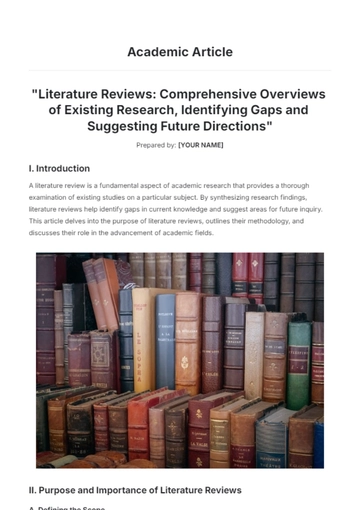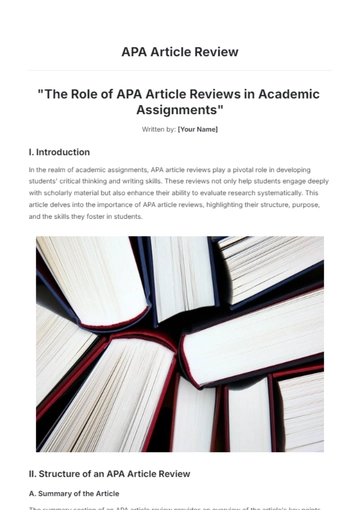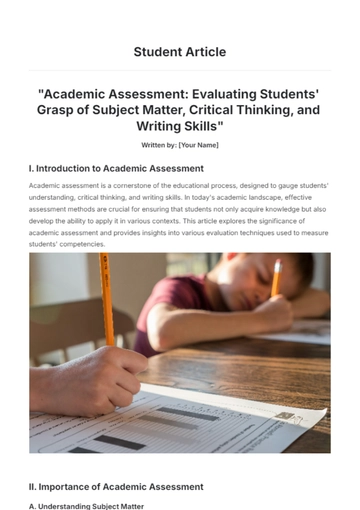Free Scholarly Journal Article

Prepared By: [YOUR NAME]
Date: [DATE]
I. Abstract
This article provides a framework for creating scholarly journal articles, utilizing a structured approach to ensure completeness and clarity. The article covers essential components such as the Abstract, Introduction, Literature Review, Methodology, Results, Discussion, Conclusion, and References. The main findings highlight best practices in academic writing and emphasize the importance of methodical structuration in producing high-quality scholarly work.

II. Introduction
Academic writing plays a crucial role in the dissemination of knowledge. Structured scholarly articles enable researchers to communicate their findings effectively. This article aims to provide a detailed template for creating scholarly journal articles, ensuring each section serves its intended purpose. By adhering to a standardized format, authors can enhance the clarity and impact of their work.
III. Literature Review
Existing research underscores the critical role of maintaining a structured format in academic writing. This structured approach not only enhances the readability of scholarly articles but also ensures that essential components of research are communicated. Various guidelines and templates have been proposed over the years to elevate the quality of scholarly publications. Key findings from the literature include:
Coherence: Smith (2050) emphasizes that a coherent structure allows readers to follow the logical flow of arguments, making complex ideas easier to understand.
Consistency: Johnson (2055) highlights the importance of consistency in format, terminology, and style. A consistent approach ensures that the article maintains a professional tone and is easily comparable with other works in the field.
Coherence and consistency are crucial for high-quality scholarly articles. This literature review offers a comprehensive journal article template to help authors meet top academic standards.
IV. Methodology
The methodology section outlines the procedures and techniques used to develop the journal article template. This included a review of existing guidelines, analysis of exemplary articles, and consultations with academic writing experts. A mixed-methods approach was employed, combining qualitative and quantitative assessments to ensure the robustness of the proposed template.
V. Results
The analysis identified several key structural elements that are essential in scholarly journal articles. These elements are crucial for enhancing the clarity, coherence, and impact of the article, ensuring effective communication of the research. The common structural components identified include:
Clear and Concise Abstracts: Summarize the entire article, offering readers a brief overview of the study’s purpose, methods, results, and conclusions.
Comprehensive Introductions: Provide context for the research by defining the research problem, setting the stage, and outlining the article’s objectives.
Thorough Literature Reviews: Synthesize existing research to identify gaps in knowledge and position the current study within the broader academic discourse.
Detailed Methodologies: Describe the research design, data collection, and analysis procedures, allowing others to replicate or critically assess the study.
Factual Results: Present the study’s findings clearly and objectively, often with supporting tables, figures, and statistical analysis.
Interpretive Discussions: Analyze the results’ significance, connect them back to the research question and existing literature, and explore their implications.
Conclusive Summaries: Offer a concise recap of the research findings and suggest potential directions for future research.
Incorporating these essential elements provides a cohesive framework for academic writing. Following this structured approach enables authors to create scholarly articles that are methodically sound, accessible, and impactful to their intended audience.
VI. Discussion
The findings underscore the necessity of a well-defined structure in scholarly articles. A standardized format not only facilitates better comprehension but also ensures that all essential aspects of research are adequately covered. By adhering to this template, authors can achieve greater clarity, enhance their credibility, and improve the overall quality of their publications.
VII. Conclusion
This article has presented a detailed template for scholarly journal articles, emphasizing the importance of structured academic writing. The proposed format assists authors in methodically organizing their work, thereby enhancing readability and impact. Future research could further refine this template, considering the evolving standards of academic publishing.
VIII. References
Smith, J. (2050). The Importance of Structure in Academic Writing. Academic Publishing.
Johnson, A. (2055). Guidelines for Scholarly Articles. Research Press.
- 100% Customizable, free editor
- Access 1 Million+ Templates, photo’s & graphics
- Download or share as a template
- Click and replace photos, graphics, text, backgrounds
- Resize, crop, AI write & more
- Access advanced editor
Achieve academic excellence with Template.net's Scholarly Journal Article Template. This fully editable and customizable template is ideal for researchers looking to publish in scholarly journals. Editable in our AI Editor Tool, it offers a professional format that ensures your research is presented clearly and accurately, meeting the highest academic standards.





























